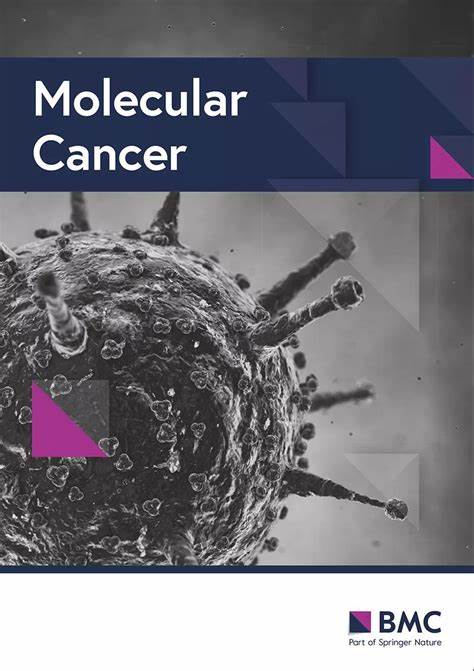治疗性衰老是乳腺癌中一种短暂的耐药机制
IF 33.9
1区 医学
Q1 BIOCHEMISTRY & MOLECULAR BIOLOGY
引用次数: 0
摘要
治疗性衰老(TIS)被认为是dna损伤治疗后的永久性细胞周期阻滞;然而,它的不可逆性最近受到了挑战。在这里,我们证明了从TIS中逃逸是乳腺癌细胞的普遍现象。此外,TIS提供了一种可逆的耐药机制,确保了人群的生存,并可能导致复发。在四种不同的乳腺癌细胞系中,用大剂量化疗诱导TIS,并培养至细胞逃离TIS。亲代细胞、TIS细胞和再生代细胞通过单细胞RNA测序和表面蛋白质组学进行分析。一种基因工程的三阴性乳腺癌小鼠模型被用来证明为什么目前的抗衰老药物不能克服肿瘤中的TIS。对fda批准的多种抗癌药物的毒性筛选显示,尽管这些化合物的作用机制不同,但TIS对其中一半的化合物产生了抗药性。大量和单细胞RNA测序,以及表面蛋白质组学分析表明,虽然亲代和再生细胞几乎相同,但TIS细胞与两者显着不同,突出了它们的短暂性。此外,调查了数十种已知的耐药机制,也无法解释这种独特的耐药模式。此外,TIS细胞表达了一组与免疫逃避和潜在的kras驱动的TIS逃避机制相关的基因。我们的研究结果表明,作为一种短暂的耐药机制,TIS可能有助于克服免疫反应,并通过恢复到增殖阶段而复发。本文章由计算机程序翻译,如有差异,请以英文原文为准。
Therapy-induced senescence is a transient drug resistance mechanism in breast cancer
Therapy-induced senescence (TIS) is considered a permanent cell cycle arrest following DNA-damaging treatments; however, its irreversibility has recently been challenged. Here, we demonstrate that escape from TIS is universal across breast cancer cells. Moreover, TIS provides a reversible drug resistance mechanism that ensures the survival of the population, and could contribute to relapse. TIS was induced in four different breast cancer cell line with high-dose chemotherapy and cultured until cells escaped TIS. Parental, TIS and repopulating cells were analyzed by bulk and single-cell RNA sequencing and surface proteomics. A genetically engineered mouse model of triple-negative breast cancer was used to prove why current senolytics cannot overcome TIS in tumors. Screening the toxicity of a diverse panel of FDA-approved anticancer drugs revealed that TIS meditates resistance to half of these compounds, despite their distinct mechanism of action. Bulk and single-cell RNA sequencing, along with surface proteome analysis, showed that while parental and repopulating cells are almost identical, TIS cells are significantly different from both, highlighting their transient nature. Furthermore, investigating dozens of known drug resistance mechanisms offered no explanation for this unique drug resistance pattern. Additionally, TIS cells expressed a gene set associated with immune evasion and a potential KRAS-driven escape mechanism from TIS. Our results reveal that TIS, as a transient drug resistance mechanism, could contribute to overcome the immune response and to relapse by reverting to a proliferative stage.
求助全文
通过发布文献求助,成功后即可免费获取论文全文。
去求助
来源期刊

Molecular Cancer
医学-生化与分子生物学
CiteScore
54.90
自引率
2.70%
发文量
224
审稿时长
2 months
期刊介绍:
Molecular Cancer is a platform that encourages the exchange of ideas and discoveries in the field of cancer research, particularly focusing on the molecular aspects. Our goal is to facilitate discussions and provide insights into various areas of cancer and related biomedical science. We welcome articles from basic, translational, and clinical research that contribute to the advancement of understanding, prevention, diagnosis, and treatment of cancer.
The scope of topics covered in Molecular Cancer is diverse and inclusive. These include, but are not limited to, cell and tumor biology, angiogenesis, utilizing animal models, understanding metastasis, exploring cancer antigens and the immune response, investigating cellular signaling and molecular biology, examining epidemiology, genetic and molecular profiling of cancer, identifying molecular targets, studying cancer stem cells, exploring DNA damage and repair mechanisms, analyzing cell cycle regulation, investigating apoptosis, exploring molecular virology, and evaluating vaccine and antibody-based cancer therapies.
Molecular Cancer serves as an important platform for sharing exciting discoveries in cancer-related research. It offers an unparalleled opportunity to communicate information to both specialists and the general public. The online presence of Molecular Cancer enables immediate publication of accepted articles and facilitates the presentation of large datasets and supplementary information. This ensures that new research is efficiently and rapidly disseminated to the scientific community.
 求助内容:
求助内容: 应助结果提醒方式:
应助结果提醒方式:


